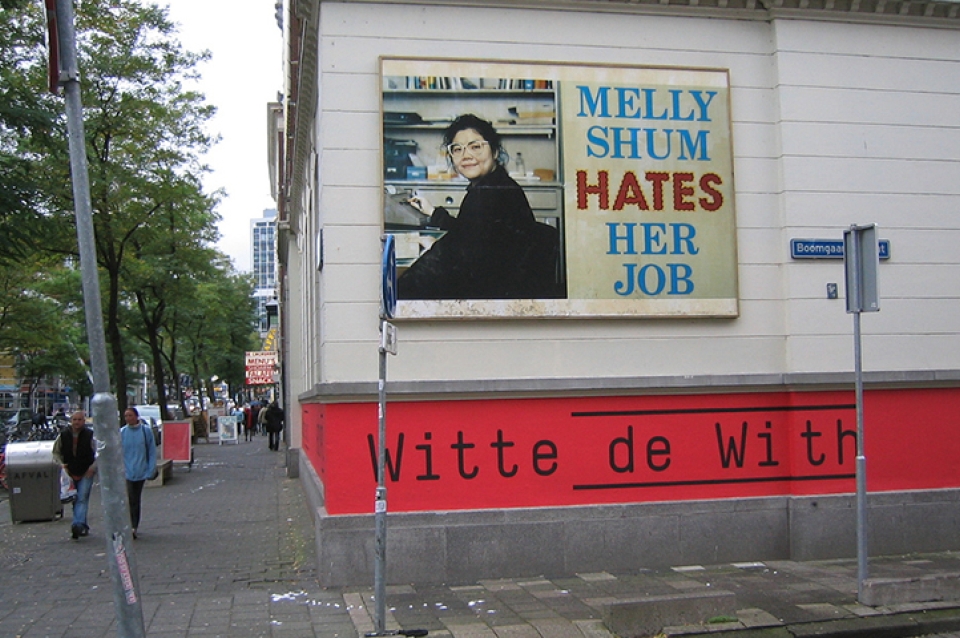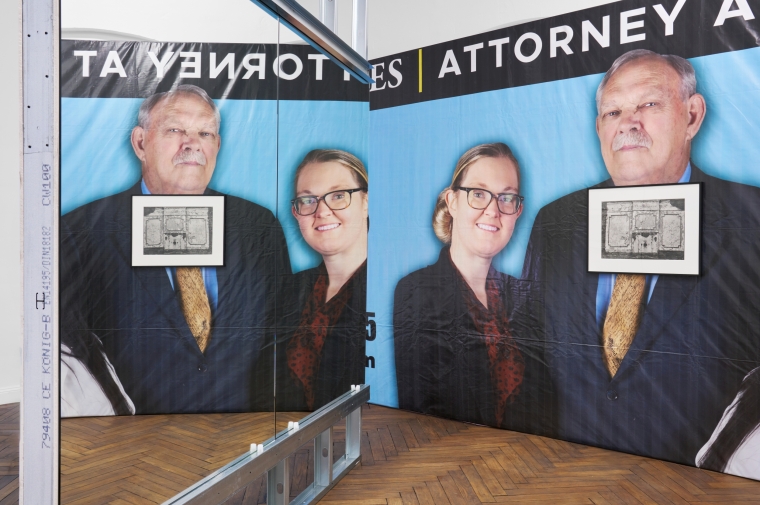October 11, 2020
Stuart Weitzman School of Design
102 Meyerson Hall
210 South 34th Street
Philadelphia, PA 19104
Get the latest Weitzman news in your Inbox
Ken Lum had his first solo exhibition in 1990, at the Witte de With Center for Contemporary Art in Rotterdam. It was the center’s first exhibition too, and Lum says the curators wanted to use a former billboard slot, in a corner of the facade facing Boomgaardsstraat, to advertise the show. He agreed, on the condition that the space would display a work of art but not mention his name, the exhibition, or the dates of the show. He selected a piece from the exhibition. It was a photograph of a young woman seated at a desk in an office, smiling at the camera, accompanied by the phrase MELLY SHUM HATES HER JOB.
Thirty years later, Lum’s work has traveled the world, and Melly Shum has become an iconic Rotterdam landmark. And as of this month, the Witte de With Center has been renamed Kunstinstituut Melly, in honor of the piece.
“I thought this might be kind of funny,” says Lum of the decision to use the Melly piece to advertise his first show. “But I certainly didn’t anticipate the response it got.”
Today, Lum is the Marilyn Jordan Taylor Presidential Professor and chair of fine arts at the Weitzman School, chief curatorial advisor for Monument Lab, and faculty director at the Center for Public Art and Space. He says he didn’t expect the Melly piece to remain on display for more than the length of the show. And in fact, it was taken down shortly after the exhibition ended. But during the few months when it was initially displayed, it made such an impression that the center was compelled, more or less by popular demand, to put it back.
“Apparently people wrote letters and made phone calls,” Lum says. “One person said that every city deserves a monument to people who hate their jobs. I remember just being a little bit incredulous.”
The Kunstinstituut Melly was originally named for a Dutch naval officer who lived during an era of colonial expansion in the 17th century. In 2017, a group of artists and activists published an open letter to the center challenging its leaders to confront the institution’s “entanglement with colonial violence.” The center, which sits at the corner of Witte de Withstraat and Boomgaardsstraat in a part of Rotterdam that Lum says is “totally hipsterville,” began its renaming process in 2018. The center’s announcement of the renaming refers to the character in the photograph as a “working-class anti-hero.”
“I didn’t think that was quite accurate, but I think it’s really a contrast from the white rich guys who usually get the names of power,” Lum says. “Here’s someone (Melly) who is not wealthy, who is anonymous, someone who is an everyperson, who is othered, who is maybe the daughter of immigrants — who knows? And I think that is delicious.”
As it happens, the renaming dovetails with Lum’s work with Monument Lab, which has helped to push forward a movement to reconsider the legacy of America’s public art and monuments, the people they depict, and the messages about culture and power they’re meant to project. This month, Monument Lab received a $4 million grant from the Mellon Foundation to expand its work of “making generational change in the ways art and history live in public,” in the words of director Paul Farber. The grant will allow the organization to establish office space, hire new people, pay some people who have been volunteering, and pursue many more of the projects its founders have had in mind, Lum says.
“We truly are interested in expanding democratic space,” says Lum. “And we are an odd platypus of an organization. We’re not strictly academic, we’re not university affiliated, but we do produce knowledge that can be used in academic circles, and we also think innovatively like artists do.”
Lum says it was rewarding to see his own work used to advance a similar reconsideration of public symbols in the Netherlands.
“I conceive of all my work as having some political dimension, but maybe in the philosophical sense of the term ‘polis,’” Lum says. “The piece is about labor. It is about alienation. It is about dissatisfaction. It’s even about notions of ideal citizens, how they should be depicted and so on.”
Since Lum chose the Melly piece to promote the exhibition in 1990, the people of Rotterdam have taken control of its meaning, he says. He conceived the piece, but its ownership has become public, “so it’s very democratic in that way.”
“Usually museums are named after big donors, or collectors decide to pay for their own museums,” Lum says. “That’s what’s so delightful about this whole story for me. It’s not something artists plan for, that’s for sure.”


 Expand Image
Expand Image

